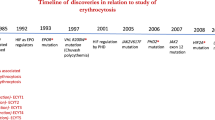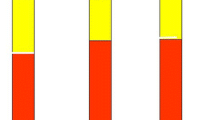Abstract
Idiopathic erythrocytosis (IE) is an absolute erythrocytosis with no known cause, diagnosed by exclusion of primary and secondary erythrocytosis. Familial erythrocytosis (FE) is a rare disease and as the rare patients with JAK2-wild-type polycythemia vera (PV) may be misdiagnosed as IE. We compared 78 patients with IE, 21 with FE and 136 with PV in the effort to identify simple features capable of discriminating between them. FE patients were younger at diagnosis either than IE and PV (p < 0.001); IE and FE had lower WBC, platelet counts and higher serum EPO levels, and had splenomegaly and thrombotic events less frequently than PV patients. Phlebotomies to obtain a haematocrit lower than 45 % induce platelet count increase in 70 % of PV but not in IE. Mainly in men, normal spleen, normal platelet counts and no history of thrombosis at diagnosis argue against PV; diagnosis of IE could be supported by means of a cycle of venesection to see how it affects their platelet count. No simple data capable of distinguishing between IE and FE were identified; therefore, a case of sporadic erythrocytosis in a young patient should be investigated as a possible genetic cause.
Similar content being viewed by others
References
Pearson TC, Guthrie DL, Simpson J et al (1995) Interpretation of measured red cell mass and plasma volume in adults: Expert Panel on Radionuclides of the International Council for Standardization in Haematology. Br J Haematol 89:748–756
Vardiman JW, Thiele J, Arber DA et al (2008) The 2008 revision of World Health Organization (WHO) classification of myeloid neoplasms and acute leukemia: rationale and important changes. Blood 114:937–951
McMullin MF (2008) The classification and diagnosis of erythrocytosis. Int J Lab Hematol 30:447–459
James C, Ugo V, Coudec JP et al (2005) A unique clonal JAK2 mutation leading to constitutive signalling causes polycythemia vera. Nature 434:114–118
Scott LM, Tong W, Levine RL et al (2007) JAK2 exon 12 mutations in polycythemia vera and idiopathic erythrocytosis. N Engl J Med 356:459–468
Patnaik MM, Tefferi A (2009) The complete evaluation of erythrocytosis: congenital and acquired. Leukemia 23:834–844
Bento C, Percy MJ, Gardie B, Maia TM, van Wijk R, Perrotta S et al (2013) Genetic basis of congenital erythrocytosis: mutation update and online databases. Hum Mutat 35:15–26
Sokol L, Luhovy M, Prchal JF et al (1995) Primary familial polycythemia: a frameshift mutation in the erythropoietin receptor gene and increased sensitivity of erythroid progenitors to erythropoietin. Blood 86:15–22
McMullin MF. Idiopathic erythrocytosis: a disappearing entity. Am Soc Hematology 2009:629-35
Pastore YD, Jelinek J, Ang S et al (2003) Mutations in the VHL gene in sporadic apparently congenital polycythemia. Blood 101:1591–1595
Randi ML, Murgia A, Putti MC et al (2005) Low frequency of VHL gene mutations in young individuals with polycythemia and high serum erythropoietin. Haematologica 90:689–691
Ruggeri M, Tosetto A, Frezzato M, Rodeghiero F (2003) The rate of progression to polycythemia vera or essential thrombocythemia in patients with erythrocytosis or thrombocytosis. Ann Intern Med 139:470–475
Pearson TC, Messinezy M (2001) Idiopathic erythrocytosis, diagnosis and management. Pathologie-Biologie 49:170–177
Tefferi A, Barbui T (2014) Polycythemia vera and essential thrombocythemia: 2015 update on diagnosis, risk stratification and management. Am J Haematol 90:163–173
Finazzi G, Gregg XT, Barbui T, Prchal JT (2006) Idiopathic erythrocytosis and other non-clonal polycythemias. Best Clin Pract Res Clin Hematol 19:471–482
Mc Mullin MF (2012) Diagnosis and management of congenital and idiopathic erythrocytosis. Ther Adv Hematol 3:391–398
Landolfi R, Nicolazzi MA, Porfidia A, Di Gennaro L (2010) Polycythemia vera. Intern Emerg Med 5:375–384
Formenti F, Beer P, Croft Q et al (2011) Cardiopulmonary function in two human disorders of the hypoxiainducible (HIF) pathway: von Hippel-Lindau disease and HIF-2α gain-of-function mutation. FASEB J 25:2001–2011
Falanga A, Marchetti M (2012) Thrombotic disease in the myeloproliferative neoplasms. Am Soc Hematol Educ Progran 571:81
Marchioli R, Finazzi G, Specchia G et al (2013) Cardiovascular events and intensity of treatment in polycythemia vera. N Engl J Med 368:22–33
Gordeuk VR, Sergueeva AL, Miasnikova GY et al (2004) Congenital disorder of oxygen-sensing: association of the homozygous Chuvash polycythemia VHL mutation with thrombosis and vascular abnormalities but not tumors. Blood 103:3924–3932
Smalberg JH, Arends LR, Valla DC, Kiladjian JJ, Janssen HLA, Leebeek WG (2012) Myeloproliferative neoplasms in Budd-Chiari syndrome and portal vein thrombosis: a meta-analysis. Blood 120:4921–4928
Acknowledgments
This study was supported in part by the Italian MIUR grant.
Author contribution
MLR designed the study, analysed the data and wrote the manuscript; IB, EC and CS contributed clinical information; EP performed the molecular analyses; FF provided major intellectual contribution to the manuscript. All authors have read and approved the final version and agree to act as guarantor of the work.
Author information
Authors and Affiliations
Corresponding author
Ethics declarations
Conflict of interest
The authors declare that they have no conflict of interest.
Rights and permissions
About this article
Cite this article
Randi, M.L., Bertozzi, I., Cosi, E. et al. Idiopathic erythrocytosis: a study of a large cohort with a long follow-up. Ann Hematol 95, 233–237 (2016). https://doi.org/10.1007/s00277-015-2548-z
Received:
Accepted:
Published:
Issue Date:
DOI: https://doi.org/10.1007/s00277-015-2548-z




